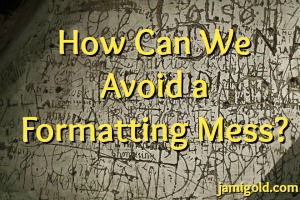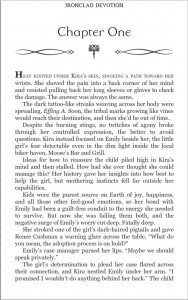Long before I decided to indie publish, I began keeping the option in the back of my mind. I read articles about self-publishing, I learned the steps of the process, and I started bookmarking cover artists and editors as I came across recommendations. I even audited an ebook formatting class and attended a workshop on ebook formatting at a conference.
With those latter classes, I didn’t really feel like learning all the technical stuff involved, so I was mostly hoping to get an idea for how to tell if a formatter was any good or not. I’d heard stories about ebooks from reputable indie authors or traditional publishers suffering from formatting problems, and I didn’t want to run into the same issues.
Yet if we don’t know the technical stuff ourselves, we can be at a loss for how to tell a good formatter from a bad one. I wouldn’t know what bad code looked like unless it highlighted itself in a bright “delete me!” shade. *smile*
Luckily, by the time I was ready to pull the trigger on indie publishing, I had a solution. My good friend and beta buddy, Angela Quarles, was thinking of offering ebook formatting as a side business after enjoying working on her own books so much.
I knew Angela had plenty of experience with HTML and CSS code for website design, and ebooks are essentially like webpages in that regard. Ebooks use the same type of code structure for formatting, so she’d know when code was bad or not needed because she’s lived and breathed this stuff.
…So I volunteered myself as guinea pig to convince her to start this business. *grin*
However, I know that we don’t all have a genius like Angela on call, so I figured that others might still have the same questions I had:
- How can we tell a good formatter from a less-skilled one? (especially if we can’t see or understand the code of samples?)
- What issues should we watch out for?
- What questions should we ask?
Even if we’re traditionally publishing, we might want to judge whether our publisher knows what they’re doing for ebook publishing. Or if we’re planning on formatting our own books, we might want to know what the common pitfalls are, so we can avoid them as well.
To that end, I asked Angela to come by and fill us in on what we need to know about formatting for ebook publishing. Please welcome Angela Quarles! *smile*
*****
The Pitfalls of eBook Formatting (especially across Platforms):
What to Look for in a Formatter
Ah, the smell of varied standards amongst ebook vendors! Reminds me of the old, wild days coding websites during the “Browser Wars”—remember Netscape? Didn’t think so.
Anyway, I used to code websites back during the late 90s/early aughts, when you’d have to write exceptions into your code to account for which browser a website would be served on. I won’t get too technical, but it was a you-know-what.
Coding ebooks now reminds me of those halcyon days. If you’re only on Amazon, you might not worry too much, but even there, some things will be rendered differently depending on if it’s using the kf8 format or the mobi format.
So, you’re hiring this out so you don’t have to deal? Great! Just make sure your formatter has the experience in working across platforms, not just Amazon. Here are some things to look out for.
Do They Know All the Quirks of All the Platforms?
Sadly, even though there are standards in place, not all of the reading devices pay attention to them. Let me share some examples of how the different ebook platforms can vary…
Widows and Orphans
These are controls that will tell the e-reader device whether or not to break a paragraph across two pages, and if so, what the tolerance level is in number of lines. Some vendors, like Nook, will have the default for this set at two, while Amazon doesn’t even bother with it.
Personally, I don’t like Nook’s default setting, though this is a personal taste. If you want to not have your pages end two lines early on some pages, then make sure you tell your formatter that you don’t want to set widows and orphans at the default setting (Note: I set mine to 1, so this is what you can tell your formatter you want yours to be if your taste matches mine).
Centering Headings
Nook strikes again if you’re wanting your headings centered. I’m going to get a little technical here, but with Amazon’s format, all you had to do was make your header tag centered in your stylesheet, but that won’t work on Nook and some other e-readers. You have to make a specific “class” for it and call that class in your header tag.
One way to test if your formatter codes for this quirk is to look at some of their books. Are the chapter headings centered in Amazon’s Look Inside, but not on Nook?
Spaces between Paragraphs
While you’re there in Nook, see if there are extra spaces between paragraphs. Some older Nooks have to have the CSS code treated in a certain way in order for it not to insert these extra spaces.
Embedded Fonts
Also, if you’re wanting embedded fonts, make sure they know how to code for that in Apple and Nook.
This by no means exhausts how each e-reader can ignore specifications, but they are the most visible and common pitfalls, so these can be a good test to evaluate your formatter.
Do They Know How to Keep Your File Size Small?
You might not think file size matters for ebooks, but it does. If your book is priced higher than 99 cents, Amazon charges you a download fee based on the file size of your book (minus the cover). It’s in the pennies per book, but if you sell a lot, this can add up over the course of a year.
They Should Know How to Adjust Image Size
Make sure your formatter knows how to shrink any images (other than your cover) to be the smallest it can be and still look good.
They Should Know How to Work with HTML and CSS Code
Also, make sure they’re working with your actual code. By that I mean that they aren’t just taking your Word file and putting it through a software program and handing it back to you without delving into the code itself.
You want someone with HTML and CSS coding background, because you might not realize this, but when you run it through one of these programs, it adds a bunch crufty code. It gets worse when you put it through several, and it starts to weigh your file down like a bunch of junk DNA.
They Should Know the Tools for Generating Clean Code
I’m going to be a snob about this, but really the only two ePub tools that I know of that can produce the cleanest code are Atlantis Word Processor and Sigil, so if you hear those in their arsenal, great. Some also use website-building software like Dreamweaver. Some hardy souls even edit the files in Notepad. Whatever allows them to actually see the code and clean it up.
For those using Scrivener, their ePub is pretty close to being clean, and if you don’t require much else as far as customization, in most cases a Scrivener-produced file can validate. But many of the other ePub tools you hear about tack on a lot of crufty code; they don’t output clean files.
If your book is going to be 99 cents or permafree, then this won’t matter at all, since there will be no surcharge for file size. But if you have a large book, this would be something to consider.
What Tools Do I Use?
If I’m formatting one of my own books, I export the ePub from Scrivener, and open it up in Sigil to do some quick adjustments. Then I change the file extension from .epub to .zip and unzip it.
This is an awesome trick, which many might not know—epub files are really just zipped up HTML (and other) files. So if you change the extension, you can then unzip it and see all of your files that make up your book.
I like to use Adobe Dreamweaver to then do some heavy lifting in the search and replace department and general cleanup. Then I rezip it, change the extension back to .epub, and open it back up in Sigil to do the rest of the cleanup and styling.
If I’m formatting for a client and they hand me a Word doc, I like to get that converted into an epub by using Atlantis Word Processor and exporting it as an ebook. Then I do the same as above to get it cleaned up and stylized like I want.
*****
 Angela Quarles is a geek girl romance writer. What makes her romances geeky?
Angela Quarles is a geek girl romance writer. What makes her romances geeky?
Whether it’s fan girling over Ada Lovelace by having her as a secondary character in Must Love Breeches, or outright geek references with geek types in her romantic comedy with paranormal elements, Beer and Groping in Las Vegas, or going all Southern steampunk in Steam Me Up,Rawley, she likes to have fun with her romances and hopes her readers do too. Her latest release, Must Love Chainmail, takes readers back to 13th century Wales.
Angela has had a varied career, including website programming and directing a small local history museum, and has discovered that writing allows her to explore all her interests. She lives in Mobile, AL and works by day at an independent bookstore. You can find her at her website, Twitter, Facebook, or Goodreads. You can also join her mailing list to get the latest news.
*****
 Geek Girl Author Services takes care of the nitty gritty so you can spend time on your writing.
Geek Girl Author Services takes care of the nitty gritty so you can spend time on your writing.
Angela handles print and ebook formatting, as well as editing and marketing services. Find her online at her website or on Facebook.
*****
Thank you, Angela! As everyone can see, I successfully convinced her to start her Geek Girl Author Services company. *rubs hands together* And she did a fantastic job!
Here’s a sneak peek at the first page of the ebook format for my upcoming motorcycle-riding faerie princess story, Ironclad Devotion:
There’s so much we have to learn about publishing when we start down the writing path, even if we stay on the traditional route, and ebook formatting is one more thing on that list. No matter who formats our books, it’s best if we understand the basics and know the red flags to watch out for.
This advice can help us all know what questions to ask of our potential formatter. Or they can help us know what common issues to watch out for when doing our own formatting.
I also like Angela’s tips for how to look at a formatter’s sample work and see if their formatted stories contain any of these problems. Even if we’re pursuing traditional publishing, we might judge potential publishers on formatting issues just as we do for crappy covers.
All together, this advice can give us a sense of confidence that the formatter we work with is skilled enough to do a good job. And when publishing, we have enough other issues to worry about that it’s worth it to kick items off that “worry” list.
Some might think formatting isn’t that important, but at the end of the day, we want to keep readers immersed in our story, and we don’t want all our hard work on story craft to be undermined when a formatting glitch pulls readers out of the story. So yes, formatting is important too. *smile*
Have you seen odd formatting in ebooks? Were they traditionally or self-published? Did the glitch pull you out of the story? Do you have any other tips on how to evaluate formatters? Do you have any questions for Angela?


